How Many Megabytes Of Data Can A Factory Made Audio Cd Hold?
 | |
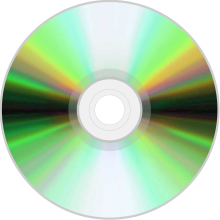 The readable surface of a meaty disc includes a spiral runway wound tightly enough to cause light to diffract into a full visible spectrum. | |
| Media blazon | Optical disc |
|---|---|
| Encoding | Diverse |
| Chapters | Typically upward to 700 MB (upwards to lxxx minutes' audio) |
| Readmechanism | 780 nm wavelength (infrared and red border) semiconductor laser (early players used helium–neon lasers),[ane] 1,200 Kbit/s (1×) |
| Writemechanism | 780 nm wavelength (infrared and red border) semiconductor laser in recordable formats CD-R and CD-RW, pressed mold (stamper) in read only formats |
| Standard | Rainbow Books |
| Adultby | Philips, Sony |
| Usage | Audio and data storage |
| Extendedto |
|
| Released |
|
The compact disc (CD) is a digital optical disc data storage format that was co-adult by Philips and Sony to store and play digital audio recordings. In August 1982, the get-go meaty disc was manufactured. It was so released in October 1982 and branded equally Digital Audio Compact Disc.
The format was subsequently adapted for storage of information (CD-ROM). Several other formats were further derived from these, including write-once sound and data storage (CD-R), rewritable media (CD-RW), Video CD (VCD), Super Video CD (SVCD), Photo CD, Picture CD, Meaty Disc-Interactive (CD-i) and Enhanced Music CD.
Standard CDs have a diameter of 120 millimetres (4.7 in) and are designed to hold upwardly to 74 minutes of uncompressed stereo digital audio or about 650 MB of information. Capacity is routinely extended to 80 minutes and 700 MB by arranging data more than closely on the same sized disc. The Mini CD has diverse diameters ranging from 60 to 80 millimetres (ii.4 to 3.ane in); they are sometimes used for CD singles, storing up to 24 minutes of audio, or delivering device drivers.
At the time of the technology's introduction in 1982, a CD could shop much more data than a personal computer hard disk drive drive, which would typically hold 10 MB. By 2010, hard drives normally offered as much storage space as a thousand CDs, while their prices had plummeted to article level. In 2004, worldwide sales of sound CDs, CD-ROMs, and CD-Rs reached about thirty billion discs. By 2007, 200 billion CDs had been sold worldwide.[ii]
Physical details [edit]

Diagram of CD layers
- A polycarbonate disc layer has the data encoded by using bumps.
- A shiny layer reflects the laser.
- A layer of lacquer protects the shiny layer.
- Artwork is screen printed on the pinnacle of the disc.
- A laser axle reads the CD and is reflected to a sensor, which converts it into electronic data
A CD is made from i.2-millimetre (0.047 in) thick, polycarbonate plastic and weighs 14–33 grams.[iii] From the center outward, components are: the center spindle hole (15 mm), the first-transition area (clamping ring), the clamping area (stacking band), the 2nd-transition area (mirror ring), the programme (information) area, and the rim. The inner plan surface area occupies a radius from 25 to 58 mm.
A thin layer of aluminum or, more than rarely, gold is applied to the surface, making it reflective. The metal is protected by a film of lacquer normally spin coated directly on the reflective layer. The label is printed on the lacquer layer, normally past screen printing or offset printing.
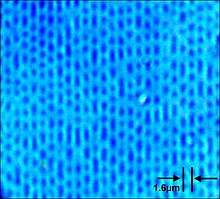
Pits and Lands of a compact disc under a microscope
CD information is represented equally tiny indentations known equally pits, encoded in a screw track moulded into the top of the polycarbonate layer. The areas between pits are known equally lands. Each pit is approximately 100 nm deep by 500 nm wide, and varies from 850 nm to 3.five µm in length.[4] The altitude between the tracks (the pitch) is 1.vi µm.[5] [6] [seven]
When playing an sound CD, a motor inside the CD player spins the disc to a scanning velocity of ane.2–1.4 m/s (abiding linear velocity, CLV)—equivalent to approximately 500 RPM at the inside of the disc, and approximately 200 RPM at the exterior edge. The track on the CD begins at the within and spirals outward so a disc played from start to finish slows its rotation rate during playback.
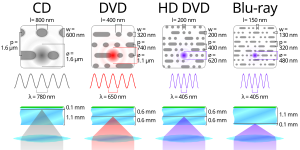
Comparison of various optical storage media
The program area is 86.05 cmii and the length of the recordable screw is 86.05 cm2 / 1.half dozen µm = v.38 km. With a scanning speed of 1.2 thou/southward, the playing fourth dimension is 74 minutes, or 650 MB of data on a CD-ROM. A disc with data packed slightly more than densely is tolerated by most players (though some one-time ones fail). Using a linear velocity of i.2 1000/s and a narrower track pitch of 1.5 µm increases the playing time to 80 minutes, and data chapters to 700 MB.
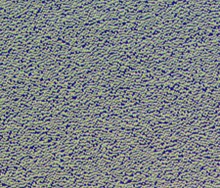
The pits in a CD are 500 nm wide, between 830 nm and 3,000 nm long and 150 nm deep.
A CD is read past focusing a 780 nm wavelength (near infrared) semiconductor laser through the bottom of the polycarbonate layer. The change in height betwixt pits and lands results in a difference in the way the low-cal is reflected. Because the pits are indented into the peak layer of the disc and are read through the transparent polycarbonate base of operations, the pits form bumps when read.[eight] The laser hits the disc, casting a circle of lite wider than the modulated spiral track reflecting partially from the lands and partially from the meridian of any bumps where they are nowadays. Every bit the laser passes over a pit (bump), its pinnacle ways that the role of the low-cal reflected from its height is ane/2 wavelength out of phase with the low-cal reflected from the land around it. This causes partial cancellation of the laser's reflection from the surface. By measuring the reflected intensity change with a photodiode, a modulated signal is read dorsum from the disc.
To accommodate the spiral pattern of data, the laser is placed on a mobile mechanism within the disc tray of whatever CD player. This machinery typically takes the form of a sled that moves along a rail. The sled can be driven by a worm gear or linear motor. Where a worm gear is used, a 2nd shorter-throw linear motor, in the form of a coil and magnet, makes fine position adjustments to track eccentricities in the disk at loftier speed. Some CD drives (peculiarly those manufactured past Philips during the 1980s and early 1990s) use a swing arm similar to that seen on a gramophone. This mechanism allows the light amplification by stimulated emission of radiation to read information from the center to the edge of a disc without having to interrupt the spinning of the disc itself.[ farther caption needed ]
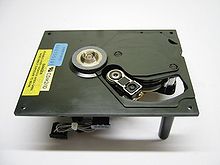
The pits and lands exercise not directly represent the 0'southward and 1'south of binary data. Instead, non-return-to-zero, inverted encoding is used: a change from either pit to land or land to pit indicates a 1, while no change indicates a serial of 0'due south. There must be at least two, and no more than than 10 0'south betwixt each 1, which is defined by the length of the pit. This, in turn, is decoded by reversing the viii-to-fourteen modulation used in mastering the disc, and then reversing the cantankerous-interleaved Reed–Solomon coding, finally revealing the raw data stored on the disc. These encoding techniques (defined in the Red Volume) were originally designed for CD Digital Sound, but they later became a standard for almost all CD formats (such as CD-ROM).
Integrity [edit]
CDs are susceptible to damage during handling and from environmental exposure. Pits are much closer to the characterization side of a disc, enabling defects and contaminants on the clear side to be out of focus during playback. Consequently, CDs are more likely to suffer harm on the characterization side of the disc. Scratches on the articulate side can be repaired by refilling them with similar refractive plastic or by careful polishing. The edges of CDs are sometimes incompletely sealed, allowing gases and liquids to enter the CD and corrode the metal reflective layer and/or interfere with the focus of the laser on the pits, a status known equally disc rot.[9] The fungus Geotrichum candidum has been institute—nether atmospheric condition of high rut and humidity—to consume the polycarbonate plastic and aluminium found in CDs.[10] [eleven]
The data integrity of compact discs tin can be measured using surface error scanning, which is able to measure the rates of unlike types of data errors, known as C1, C2, CU and extended (finer-grain) fault measurements known as E11, E12, E21, E22, E31 and E32, of which college rates bespeak a perhaps damaged or unclean data surface, low media quality, deteriorating media and recordable media written to by a malfunctioning CD author.
Error scanning can reliably predict information losses caused by media deteriorating. Support of mistake scanning varies among vendors and models of optical disc drives, and extended error scanning (known as "advanced mistake scanning" in Nero DiscSpeed) has only been bachelor on Plextor and some BenQ optical drives so far, as of 2020.[12] [13]
Disc shapes and diameters [edit]
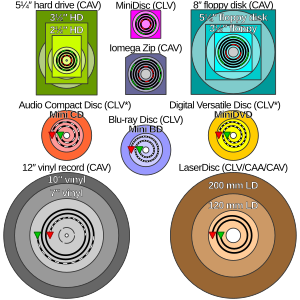
Comparing of several forms of disk storage showing tracks (not-to-scale); green denotes start and ruddy denotes end.
* Some CD-R(W) and DVD-R(West)/DVD+R(Due west) recorders operate in ZCLV, CAA or CAV modes.
The digital data on a CD begins at the eye of the disc and proceeds toward the edge, which allows accommodation to the different size formats bachelor. Standard CDs are available in two sizes. By far, the most common is 120 millimetres (4.7 in) in diameter, with a 74- or 80-minute audio capacity and a 650 or 700 MB (737,280,000-byte) data capacity. Discs are 1.two millimetres (0.047 in) thick, with a 15 millimetres (0.59 in) eye hole. The size of the pigsty isn't random, but chosen by Joop Sinjou and based on a dutch 10 cent coin: a dubbeltje.[14] Philips/Sony patented the concrete dimensions to merits copyright.[15] Philips decided to have a 110 Hz mechanical resonant frequency on the discs whilst Sony chose ninety Hz. The discrepancy caused subsequently issues on the CD Walkman.[ citation needed ]
The official Philips history says the capacity was specified by Sony executive Norio Ohga to be able to comprise the entirety of Beethoven's Ninth Symphony on one disc.[sixteen]

This is a myth according to Kees Immink, equally the EFM lawmaking format had non yet been decided in Dec 1979, when the decision to prefer the 120 mm was fabricated. The adoption of EFM in June 1980 immune 30 percent more playing fourth dimension that would have resulted in 97 minutes for 120 mm bore or 74 minutes for a disc equally small as 100 millimetres (iii.9 in). Instead, however, the information density was lowered by 30 percentage to keep the playing time at 74 minutes.[17] [18] [19] The 120 mm diameter has been adopted by subsequent formats, including Super Audio CD, DVD, Hard disk DVD, and Blu-ray Disc. The 80-millimetre (3.1 in) diameter discs ("Mini CDs") can hold up to 24 minutes of music or 210 MB.
| Physical size | Audio capacity | CD-ROM data capacity | Definition |
|---|---|---|---|
| 120 mm | 74–80 min | 650–700 MB | Standard size |
| 80 mm | 21–24 min | 185–210 MB | Mini-CD size |
| fourscore×54 mm – 80×64 mm | ~half dozen min | x–65 MB | "Business card" size |
Logical format [edit]
Audio CD [edit]
The logical format of an sound CD (officially Compact Disc Digital Sound or CD-DA) is described in a document produced in 1980 by the format'south joint creators, Sony and Philips.[twenty] The document is known colloquially every bit the Red Book CD-DA after the color of its comprehend. The format is a two-channel xvi-fleck PCM encoding at a 44.1 kHz sampling rate per channel. Four-channel sound was to exist an commanded selection within the Blood-red Book format, just has never been implemented. Monaural sound has no existing standard on a Red Book CD; thus, the mono source textile is normally presented as two identical channels in a standard Red Volume stereo track (i.e., mirrored mono); an MP3 CD, nevertheless, can have audio file formats with mono sound.
CD-Text is an extension of the Cerise Book specification for an audio CD that allows for the storage of additional text information (e.k., anthology name, song proper noun, artist) on a standards-compliant sound CD. The information is stored either in the pb-in area of the CD, where there are roughly five kilobytes of space available, or in the subcode channels R to West on the disc, which can shop about 31 megabytes.
Meaty Disc + Graphics is a special sound compact disc that contains graphics data in addition to the sound data on the disc. The disc can be played on a regular audio CD player, just when played on a special CD+G player, it tin output a graphics signal (typically, the CD+G player is hooked up to a boob tube set or a computer monitor); these graphics are almost exclusively used to brandish lyrics on a television set for karaoke performers to sing along with. The CD+G format takes advantage of the channels R through Due west. These half-dozen bits shop the graphics data.
CD + Extended Graphics (CD+EG, also known equally CD+XG) is an improved variant of the Compact Disc + Graphics (CD+One thousand) format. Like CD+G, CD+EG uses bones CD-ROM features to brandish text and video data in addition to the music being played. This extra data is stored in subcode channels R-Due west. Very few, if any, CD+EG discs have been published.
Super Audio CD [edit]
Super Audio CD (SACD) is a high-resolution read-only optical sound disc format that was designed to provide higher-allegiance digital audio reproduction than the Reddish Volume. Introduced in 1999, it was developed by Sony and Philips, the same companies that created the Red Book. SACD was in a format war with DVD-Audio, only neither has replaced sound CDs. The SACD standard is referred to as the Red Book standard.
Titles in the SACD format tin can be issued equally hybrid discs; these discs contain the SACD audio stream equally well as a standard audio CD layer which is playable in standard CD players, thus making them backward compatible.
CD-MIDI [edit]
CD-MIDI is a format used to store music-performance data, which upon playback is performed by electronic instruments that synthesize the audio. Hence, unlike the original Crimson Book CD-DA, these recordings are not digitally sampled audio recordings. The CD-MIDI format is divers every bit an extension of the original Red Volume.
CD-ROM [edit]
For the outset few years of its existence, the CD was a medium used purely for audio. Withal, in 1988, the Yellowish Book CD-ROM standard was established by Sony and Philips, which defined a non-volatile optical information computer data storage medium using the same physical format as sound compact discs, readable by a calculator with a CD-ROM bulldoze.
Video CD [edit]
Video CD (VCD, View CD, and Compact Disc digital video) is a standard digital format for storing video media on a CD. VCDs are playable in dedicated VCD players, most modern DVD-Video players, personal computers, and some video game consoles. The VCD standard was created in 1993 by Sony, Philips, Matsushita, and JVC and is referred to as the White Book standard.
Overall moving-picture show quality is intended to be comparable to VHS video. Poorly compressed VCD video tin sometimes be of lower quality than VHS video, but VCD exhibits block artifacts rather than analog dissonance and does non deteriorate further with each utilise. 352×240 (or SIF) resolution was chosen because it is one-half the vertical and one-half the horizontal resolution of the NTSC video. 352×288 is similarly 1-quarter PAL/SECAM resolution. This approximates the (overall) resolution of an analog VHS record, which, although information technology has double the number of (vertical) browse lines, has a much lower horizontal resolution.
Super Video CD [edit]
Super Video CD (Super Video Meaty Disc or SVCD) is a format used for storing video media on standard compact discs. SVCD was intended as a successor to VCD and an alternative to DVD-Video and falls somewhere between both in terms of technical capability and picture quality.
SVCD has two-thirds the resolution of DVD, and over two.7 times the resolution of VCD. One CD-R disc can concur upwards to 60 minutes of standard-quality SVCD-format video. While no specific limit on SVCD video length is mandated by the specification, 1 must lower the video bit charge per unit, and therefore quality, to accommodate very long videos. It is commonly difficult to fit much more than than 100 minutes of video onto ane SVCD without incurring a significant quality loss, and many hardware players are unable to play video with an instantaneous bit charge per unit lower than 300 to 600 kilobits per second.
Photo CD [edit]
Photo CD is a organization designed by Kodak for digitizing and storing photos on a CD. Launched in 1992, the discs were designed to hold nearly 100 loftier-quality images, scanned prints, and slides using special proprietary encoding. Photograph CDs are divers in the Biscuit Volume and conform to the CD-ROM XA and CD-i Bridge specifications besides. They are intended to play on CD-i players, Photo CD players, and any computer with suitable software (irrespective of operating system). The images tin also be printed out on photographic paper with a special Kodak automobile. This format is not to be confused with Kodak Movie CD, which is a consumer production in CD-ROM format.
CD-i [edit]
The Philips Green Book specifies a standard for interactive multimedia compact discs designed for CD-i players (1993). CD-i discs can contain audio tracks that can be played on regular CD players, but CD-i discs are not compatible with near CD-ROM drives and software. The CD-i Prepare specification was later created to improve compatibility with sound CD players, and the CD-i Bridge specification was added to create CD-i compatible discs that tin can be accessed by regular CD-ROM drives.
CD-i Gear up [edit]
Philips defined a format similar to CD-i called CD-i Set up, which puts CD-i software and information into the pregap of runway 1. This format was supposed to be more compatible with older audio CD players.
Enhanced Music CD (CD+) [edit]
Enhanced Music CD, also known as CD Extra or CD Plus, is a format which combines sound tracks and information tracks on the same disc by putting sound tracks in a first session and data in a second session. It was developed by Philips and Sony, and it is defined in the Blue Book.
VinylDisc [edit]
VinylDisc is the hybrid of a standard sound CD and the vinyl tape. The vinyl layer on the disc's label side tin concur approximately three minutes of music.
Manufacture [edit]

Individual pits are visible on the micrometer scale.
In 1995, material costs were xxx cents for the precious stone case and 10 to 15 cents for the CD. Wholesale cost of CDs was $0.75 to $1.fifteen, while the typical retail price of a prerecorded music CD was $16.98.[21] On boilerplate, the store received 35 percent of the retail cost, the record company 27 pct, the artist 16 percent, the manufacturer thirteen percent, and the distributor nine pct.[21] When 8-track cartridges, compact cassettes, and CDs were introduced, each was marketed at a higher cost than the format they succeeded, fifty-fifty though the cost to produce the media was reduced. This was washed because the apparent value increased. This continued from phonograph records to CDs, but was cleaved when Apple marketed MP3s for $0.99, and albums for $nine.99. The incremental cost, though, to produce an MP3 is negligible.[22]
Writable compact discs [edit]
Recordable CD [edit]
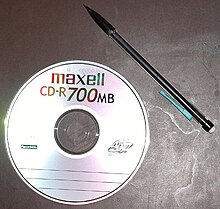
Recordable Meaty Discs, CD-Rs, are injection-molded with a "bare" information screw. A photosensitive dye is then applied, after which the discs are metalized and lacquer-coated. The write laser of the CD recorder changes the color of the dye to allow the read laser of a standard CD player to see the data, just as it would with a standard stamped disc. The resulting discs can be read by most CD-ROM drives and played in most audio CD players. CD-Rs follow the Orange Book standard.
CD-R recordings are designed to be permanent. Over time, the dye'due south physical characteristics may change causing read errors and data loss until the reading device cannot recover with error correction methods. Errors tin can be predicted using surface fault scanning. The design life is from xx to 100 years, depending on the quality of the discs, the quality of the writing bulldoze, and storage conditions.[23] All the same, testing has demonstrated such degradation of some discs in as lilliputian every bit eighteen months under normal storage conditions.[24] [25] This failure is known equally disc rot, for which there are several, mostly ecology, reasons.[26]
The recordable sound CD is designed to exist used in a consumer audio CD recorder. These consumer audio CD recorders use SCMS (Serial Re-create Direction Organization), an early on class of digital rights management (DRM), to conform to the AHRA (Audio Home Recording Act). The Recordable Audio CD is typically somewhat more expensive than CD-R due to lower production volume and a 3 per centum AHRA royalty used to compensate the music manufacture for the making of a copy.[27]
High-capacity recordable CD is a higher-density recording format that tin can concur xx% more data than of conventional discs.[28] The college capacity is incompatible with some recorders and recording software.[29]
ReWritable CD [edit]
CD-RW is a re-recordable medium that uses a metallic alloy instead of a dye. The write laser, in this instance, is used to heat and alter the backdrop (amorphous vs. crystalline) of the alloy, and hence alter its reflectivity. A CD-RW does non have as nifty a difference in reflectivity equally a pressed CD or a CD-R, and so many before CD audio players cannot read CD-RW discs, although most later CD audio players and stand-alone DVD players can. CD-RWs follow the Orange Volume standard.
The ReWritable Audio CD is designed to exist used in a consumer audio CD recorder, which will not (without modification) have standard CD-RW discs. These consumer sound CD recorders use the Serial Re-create Management System (SCMS), an early on form of digital rights management (DRM), to accommodate to the United States' Sound Abode Recording Act (AHRA). The ReWritable Audio CD is typically somewhat more expensive than CD-R due to (a) lower volume and (b) a three percentage AHRA royalty used to compensate the music manufacture for the making of a copy.[27]
Copy protection [edit]
The Ruddy Book audio specification, except for a simple "anti-copy" statement in the subcode, does not include any re-create protection machinery. Known at to the lowest degree equally early as 2001,[xxx] attempts were made past record companies to market "copy-protected" non-standard compact discs, which cannot be ripped, or copied, to hard drives or easily converted to other formats (like FLAC, MP3 or Vorbis). One major drawback to these copy-protected discs is that near will not play on either reckoner CD-ROM drives or some standalone CD players that employ CD-ROM mechanisms. Philips has stated that such discs are not permitted to bear the trademarked Compact Disc Digital Audio logo because they violate the Red Volume specifications. Numerous copy-protection systems have been countered by readily available, often costless, software, or fifty-fifty by merely turning off automatic AutoPlay to prevent the running of the DRM executable programme.
Run into also [edit]
- five.i Music Disc
- Compact disc bronzing
- Comparison of popular optical information-storage systems
- Digipak
- DualDisc
- Extended Resolution Meaty Disc
- GD-ROM
- Subconscious Track
- High Definition Compatible Digital
- Longbox
- SPARS code
- Video Single Disc
- List of optical disc manufacturers
References [edit]
- ^ Träger, Frank (5 May 2012). Springer Handbook of Lasers and Eyes. ISBN9783642194092.
- ^ "Compact Disc Hits 25th birthday". BBC News. 17 August 2007. Archived from the original on xviii February 2010. Retrieved 1 December 2009.
- ^ Pohlmann, Ken C. (1989). The Compact Disc: A Handbook of Theory and Use. A-R Editions, Inc. ISBN978-0-89579-228-0.
- ^ "Compact Disc". Archived from the original on 12 May 2016. Retrieved half dozen May 2016.
- ^ Sharpless, Graham (July 2003). "Introduction to CD and CD-ROM" (PDF). Deluxe Global Media Services Ltd. Archived (PDF) from the original on 9 March 2016. Retrieved 3 May 2016.
- ^ "IEC 60908 Audio recording - Compact disc digital audio arrangement". Archived from the original on half dozen May 2016.
- ^ "ISO/IEC 10149 Information technology -- Data interchange on read-only 120 mm optical information disks (CD-ROM)". Archived from the original on six May 2016.
- ^ An Introduction to Digital Audio, John Watkinson, 1994
- ^ Quango on Library and Information Resources: Conditions that Bear upon CDs and DVDs Archived 15 September 2016 at the Wayback Machine
- ^ Bosch, Xavier (2001). "Fungus eats CD". Nature. doi:x.1038/news010628-eleven. Archived from the original on 12 December 2013.
- ^ "Mucus 'eats' CDs". BBC. June 2001. Archived from the original on 12 December 2013.
- ^ "Philips DVD-R 8x (InfodiscR20) - Philips - Gleitz" (in German). eighteen November 2006.
- ^ "QPxTool glossary". qpxtool.sourceforge.io. QPxTool. 1 August 2008. Retrieved 22 July 2020.
- ^ "Perfecting the Compact Disc Arrangement - The half-dozen Philips/Sony meetings - 1979-1980 - DutchAudioClassics.nl". dutchaudioclassics.nl . Retrieved 26 January 2022.
- ^ "Response To Koninklijke Philips Electronics, N.Five.'s, Sony Corporation Of Nihon's And Pioneer Electronic Corporation Of Japan'south Request For Business concern Review Letter". www.justice.gov. 25 June 2015. Retrieved xiv May 2022.
- ^ "Sony chairman credited with developing CDs dies", Fox News, 24 April 2011, archived from the original on 21 May 2013, retrieved 14 Oct 2012
- ^ K.A. Schouhamer Immink (2018). "How nosotros made the compact disc". Nature Electronics. 1 . Retrieved 16 April 2018.
- ^ Chiliad. Schouhamer Immink (2007). "Shannon, Beethoven, and the Meaty Disc". IEEE Information Theory Society Newsletter. 57: 42–46. Retrieved half dozen February 2018.
- ^ Tim Buthe and Walter Mattli, The New Global Rulers: The Privatization of Regulation in the World Economy, Princeton University Press, Feb. 2011.
- ^ "IEC 60908:1999 | IEC Webstore". webstore.iec.ch. Archived from the original on 6 May 2016. Retrieved 9 July 2020.
- ^ a b Neil Strauss (five July 1995). "Pennies That Add together Upwards to $16.98: Why CD's Cost Then Much – New York Times". Nytimes.com. Archived from the original on 11 August 2013. Retrieved 25 July 2013.
- ^ Amy HarmonPublished: 12 October 2003 (12 October 2003). "MUSIC; What Cost Music?". Nytimes.com. Archived from the original on 12 May 2013. Retrieved 25 July 2013.
- ^ "Price Per Gigabyte of Popular Data Storage - Infographic". Blank Media Press. Archived from the original on 17 April 2016. Retrieved 1 Jan 2016.
- ^ "CD-R Unreadable in Less Than Two Years". cdfreaks.com. Archived from the original on 14 February 2007. Retrieved 1 February 2007.
- ^ "CD-R ROT". Archived from the original on 4 February 2005. Retrieved 1 Feb 2007.
- ^ "v. Conditions That Affect CDs and DVDs — Quango on Library and Information Resources". www.clir.org. Archived from the original on 15 September 2016. Retrieved 5 July 2016.
- ^ a b Andy McFadden (8 August 2007). "CD-Recordable FAQ". Archived from the original on 20 September 2007. Retrieved 20 September 2007.
- ^ "Understanding CD-R & CD-RW". Osta.org. Archived from the original on 1 August 2013. Retrieved 25 July 2013.
- ^ "CD-Recordable FAQ – Section three". ix January 2010. Archived from the original on 18 Nov 2013. Retrieved 25 November 2013.
Modest quantities of 90-minute and 99-infinitesimal blanks accept appeared [...] Indications are that many recorders and some software don't actually piece of work with the longer discs.
- ^ Entrada For Digital Rights (five December 2001). "Copy Protected CDs (via Archive.org)". Archived from the original on 5 December 2001.
Further reading [edit]
- Ecma International. Standard ECMA-130: Data Interchange on Read-only 120 mm Optical Information Disks (CD-ROM), 2d edition (June 1996).
- Pohlmann, Kenneth C. (1992). The Compact Disc Handbook. Middleton, Wisconsin: A-R Editions. ISBN 0-89579-300-viii.
- Peek, Hans et al. (2009) Origins and Successors of the Compact Disc. Springer Science+Business Media B.V. ISBN 978-i-4020-9552-8.
- Peek, Hans B., The emergence of the compact disc, IEEE Communications Magazine, Jan. 2010, pp. 10–17.
- Nakajima, Heitaro; Ogawa, Hiroshi (1992) Compact Disc Engineering science, Tokyo, Ohmsha Ltd. ISBN 4-274-03347-3.
- Barry, Robert (2020). Compact Disc (Object Lessons). New York: Bloomsbury. ISBN 978-1-5013-4851-8.
External links [edit]
- Video How Compact Discs are Manufactured
- CD-Recordable FAQ Exhaustive basics on CD-Recordable'due south
- Philips history of the CD (cache)
- Patent History (CD Histrion) – published by Philips in 2005
- Patent History CD Disc – published past Philips in 2003
- Sony History, Chapter eight, This is the replacement of Gramophone tape ! (第8章 レコードに代わるものはこれだ) – Sony website in Japanese
- Popularized History on Soundfountain
- A Media History of the Meaty Disc (1-hour podcast interview)
How Many Megabytes Of Data Can A Factory Made Audio Cd Hold?,
Source: https://en.wikipedia.org/wiki/Compact_disc#:~:text=Standard%20CDs%20have%20a%20diameter,about%20650%20MB%20of%20data.
Posted by: woodmomenten1943.blogspot.com


0 Response to "How Many Megabytes Of Data Can A Factory Made Audio Cd Hold?"
Post a Comment